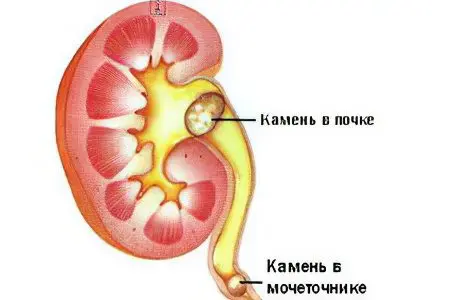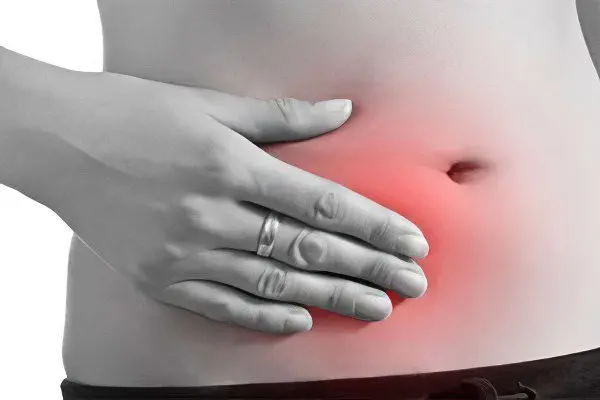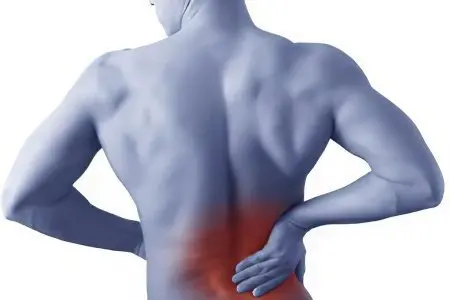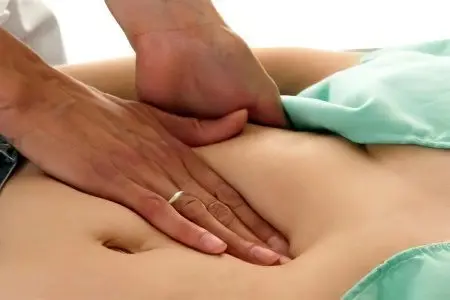Contents
- Causes of pain in the right side of the lower abdomen
- Diagnosis of pain in the right side of the lower abdomen
- Types of pain
- Other symptoms of pain in the right side
- What to do if there is pain in the right side?
Determining the causes of nonspecific pain is a serious task for neurologists, surgeons, obstetricians, gynecologists, traumatologists, orthopedists and other medical specialists. Diseases accompanied by pain in the lower abdomen are difficult to diagnose and can pose a serious danger to the patient’s health.
Causes of pain in the right side of the lower abdomen
Despite the obviousness of sensations, this is a difficult problem in diagnosing acute and chronic diseases in the pelvic area.
The pain is manifested by unpleasant sensations in the lower abdomen (including on the right side) and can be combined with pain in the projections of the body located in:
suprapubic, inguinal zone;
male genital organ;
clitoris, vagina, uterus;
urethra;
back, lower back;
buttocks, intestines.
The complexity of the problem is that a chronic pain impulse under the influence of various causes can be formed in the central nervous system in the absence of a focus in the internal organs. Therefore, even the most modern medical research often does not reveal pathological changes.
However, let’s leave the doctors the right to solve complex problems of diagnosing nonspecific pain. Instead, we will focus on the obvious causes of pain in an amount useful for the use of knowledge by a wide range of readers in order to prevent the causes of pain and timely access to a medical institution.
Common causes of pain in the lower abdomen are associated with irritation of sensitive receptors:
internal organs of the small pelvis of the right half of the body;
right hip joint, as well as bones, vessels and lymph nodes of the right leg.
Organs partially or completely located in the pelvic area, including departments:
digestion (part of the small intestine, liver, its ducts, pancreas, large intestine, including the appendix and anal area);
urinary system, paired organs (kidneys, ureters), unpaired (bladder, urethra);
female reproductive system (uterus, ovaries, oviducts, birth canal, vulva, clitoris);
male reproductive system (testicles enclosed in the scrotum, spermatic cords, male genital organ).
Outside the human abdominal cavity, pain in the right side of the lower abdomen can be caused by diseases:
the right hip joint, including the involvement of bone, cartilage tissue, blood vessels, nerve fibers, ligaments and muscles in the pathogenesis;
bones of the lower back, sacrum, coccyx, right femur, including involvement in the pathogenesis of nerves, vessels, ligaments and muscles surrounding the bone tissue.
Pain radiating or reflected to the right side and to the lower abdomen from organs that are not anatomically related to the pelvic organs are not considered in this article.
Diagnosis of pain in the right side of the lower abdomen
Such pains, always non-specific, accompany numerous diseases and physiological abnormalities. They are usually combined with other symptoms that point to the underlying cause of the disease.
Bowel disease
The most obvious pain in the lower right side, and more precisely, in the iliac region, in the groin and in the navel region, is the pain of appendicitis. Details (see here).
The main diseases that can be combined with pain in the right side of the lower abdomen:
Intestinal diverticulosis – protrusion of the walls of the intestine. The symptoms are similar to those of appendicitis. Therefore, during an operation on the appendix, an audit of the intestine is usually performed to exclude this pathology. In the pocket of the diverticulum, the contents of the intestine accumulate, irritating the nerve endings and causing pain in the lower right abdomen. In severe cases, pathology is combined with intoxication. In addition to pain, weakness, fever, constipation or diarrhea, vomiting are detected.
Intestinal obstruction. In case of intestinal volvulus, the pathogenesis is characterized by rapid development. This is due to a stop in blood flow and a violation of the innervation of the intestinal walls. With mechanical blockage of the intestine (foreign bodies), peristalsis stops and there is severe pain that radiates to the right side of the groin. It can be combined with vomiting after eating, with the absence of peristaltic noises and with the expansion of the lumen of the intestinal loops.
Duodenitis. Inflammation of the duodenum and small intestine is accompanied by pain that radiates, including to the right side. Pain is projected onto the lower abdomen with a predominant lesion of the intestinal loops located closer to the right side of the body. The pain is combined with signs of indigestion.
Inguinal hernia. Pathology is classified as a surgical disease. A hernia is a combination of two factors: rupture of the inner layers of the abdominal wall and prolapse of the omentum and intestinal loops into the subcutaneous space. The integrity of the skin with hernias is not broken. A hernia is manifested by a saccular protrusion of the skin in the groin. If during palpation it is possible to set the contents of the hernial sac inward, this is a reducible hernia. If it is impossible to set – strangulated hernia. It is a strangulated hernia that is dangerous. The intestinal loops, omentum with vessels and nerve fibers swell and swell. Their volume exceeds the diameter of the hernial ring. The pain is aggravated by physical activity. Diagnosis is not difficult. Treatment is a surgical operation to close the hernial ring.
Diseases of the liver. For the early stages of hepatitis is not typical pain reaction. Pain develops in the later stages of inflammation. In severe cases, excruciating pains appear in the lower right abdomen, the pathogenesis is accompanied by a total lesion of the organ (liver cirrhosis) and bile ducts (cholecystitis). The pain may go down to the groin area on the right side.
Rectal lesions are manifested by pain radiating to the groin.
adhesions serous membranes of internal organs. In case of damage to the nerve fibers in the lower abdomen on the right, pain in the indicated area is manifested. The causes of adhesions are postoperative complications, congenital or acquired pathologies without prior surgical intervention.
Diseases of the kidneys and bladder

Pain in different parts of the body, including the right (with right-sided lesion) in the lower abdomen.
Pain in violation of the formation of urine
Pain occurs when the kidneys lose their ability to form urine, filter and absorb purified blood back into the bloodstream. Pain syndrome accompanies inflammation of the parenchyma, renal glomeruli, pelvis and cavities, as well as degenerative, dystrophic and oncological diseases of the kidneys. The pain develops within a short time and often cannot be relieved even by strong painkillers.
Pain due to urinary incontinence
Pain develops when an obstruction is formed along the urethra and when it is impossible to excrete urine outside the body. Pathological processes are more difficult in men because of the narrow and long urethra. However, diseases in the ureters are more often detected in women due to the greater likelihood of inflammation of the female genital organs.
Painful urge to urinate is characteristic of the following diseases:
Acute dilatation of the bladder. The reason is blockage of the urethral canal by urinary stones or an inflamed prostate (in men). Manifested by ineffectual urge to urinate.
Blockage and inflammation of the ureter. Paired ureters connect the kidneys to the bladder. Pain in the groin on the right should be expected when urine stops in the distal (lower) section of the right ureter. The pain appears suddenly and very quickly increases with stagnation of urine. Various methods are used for treatment, including crushing stones with ultrasound and their surgical removal.
Inflammation of the urethra – urethritis. Both men and women get sick. In men, the disease occurs with more serious consequences. Initially, the pathology is manifested by burning and pain during urination. Pain on the right in the groin area occurs when the right inguinal lymph node is involved in the inflammatory process.
Diseases of the genital organs in men
The pain is caused by inflammatory processes, injuries or infections of the genital organs. Common symptoms of pain syndrome are pulling pains in the scrotum, radiating to the groin.
When the right lymph node is involved in the pathogenesis, the pain shifts to the corresponding area of the body:
Orchitis – inflammation of the testicles;
Inflammation of the male penis, including balanitis – inflammation of the head, and fasting – inflammation of the foreskin;
Vesiculitis – damage to the seminal vesicles. The testicles are paired organs that are located above the prostate;
Epididymitis – inflammation of the appendages of the testes;
Cavernitis – inflammation of the cavernous bodies of the male penis;
Prostatitis – inflammation of the prostate gland;
Colliculitis is an inflammation of the seminal tubercle.
Cycle disorders in women and gynecological diseases

Women have a more complex structure of the genital organs than men, and a special physiology. This determines the frequent manifestation of pain in the pelvic area in the lower abdomen, including on the right. Cycle disorders are also almost always accompanied by pain.
Pain in violation of the cycle
Pain is not always associated with obvious pathologies. Painful cycles are typical for girls and young nulliparous women. In some cases, pain is the result of infections and colds of the pelvic organs.
Menstrual pain – algomenorrhea. There is an increased blood flow to the pelvic organs, then stagnation and accumulation of blood in the uterine cavity. Pain in the absence of signs of inflammation is the primary algomenorrhea. Menstrual pain may be the result of gynecological inflammation and genital infections (secondary algomenorrhea). If spotting is irregular and accompanied by pain, this condition is called algomenorrhea. Pain in the lower abdomen often radiates to the groin and thigh, accompanied by dizziness and blurred vision, aggravated during intercourse. When layering gynecological pathologies, pain is accompanied by pathological vaginal discharge.
Obstetric pathologies
In some cases, pain is the cause of serious problems that threaten the bearing of the fetus and the health of the woman:
Pain during pregnancy. Pain of a physiological nature that occurs briefly with intense hormonal changes, increased blood flow to the uterus, fetal growth and sprains that hold the uterus in the abdominal cavity. Such pains, as a rule, are not intense and occur periodically. But pathological obstetric pain can be a sign of spontaneous abortion or ectopic pregnancy.
Pain in spontaneous abortion. Pathology develops in the early stages of pregnancy. There are several stages of spontaneous abortion: the threat of abortion and the actual abortion (complete, partial). The pain is combined with vaginal bleeding of varying intensity. Cramping pains in the lower abdomen can radiate to the right when the corresponding pain receptors are irritated. With large blood loss and infection of the birth canal with pathogenic microflora, a state of intoxication develops that threatens the life of the mother and fetus.
Pain during preterm labor. Occurs in late pregnancy in the period from 28 to 37 weeks of gestation. Pain is combined with manifestations of toxicosis in a pregnant woman. In order to avoid complications, you should urgently contact a medical institution to provide qualified obstetric care.
Pain in an ectopic pregnancy. This is a condition when a fertilized egg is fixed outside the uterine cavity. With the development of the embryo outside the uterus, the vessels and walls of the fallopian tubes are squeezed, there is a threat of rupture of the walls of the fallopian tubes and vessels on which the fertilized egg is fixed. Requires emergency surgery.
Pain in gynecological diseases
Characteristic for young women during or after previous sexual infections or hypothermia.
In old age, diseases occur with hormonal disorders:

Salpingitis. In the context of our article, this is inflammation of the right fallopian (uterine) tube. There are mechanical causes of inflammation (injuries after the consequences of abortions, childbirth and other medical procedures) and microbial causes (genital infections). Pain in the lower abdomen on the right is usually accompanied by fever. The pain syndrome is aggravated by urination, physical activity and sexual intercourse.
Adnexitis – inflammation of the ovaries and fallopian tubes. The disease usually occurs in girls and young women, sometimes it is unilateral (right-sided and left-sided adnexitis). This disease is also called “salpingoophoritis”.
Ovarian cyst – protrusion of the ovary. A bubble is formed on the ovary, filled with transparent or translucent contents, as a result, the ovary enlarges. The causes of cyst formation are hormonal disorders. Ovarian cysts are manifested by unilateral pains in the lower abdomen. Some types of cysts disappear on their own. In severe cases, surgical intervention is indicated.
Apoplexy of the ovary. Rupture of an ovarian cyst – apoplexy, accompanied by internal bleeding. Occurs when a cyst is formed of a very large size, with excessive stretching of the walls of the ovary, after exercise. It presents with pain similar to that of appendicitis. Sometimes the pain radiates to the anus, to the right side of the lower abdomen or to the thigh. Apoplexy usually occurs during ovulation. Urgent operation indicated.
Endometriosis. Gynecological disease of a non-inflammatory nature, which is characterized by increased growth of the mucous membranes of the uterus. Pathology is accompanied by changes in the hormonal background and increased bleeding. Endometriosis can develop in the genital area or outside of it, such as in the intestines. The disease is manifested by pelvic pain in the lower abdomen on the right side, accompanied by a prolongation of menstrual bleeding and pain during intercourse.
Endometritis. Inflammation of the superficial layers of the walls of the uterus. In some cases, deep layers are involved in the pathological process – endomyometritis. The main causes are sexual infections, hypothermia, hormonal disorders. In severe cases, endometritis can end with purulent inflammation and accumulation of exudate in the uterus (pyometra). Endometritis is manifested by pain in the lower abdomen, sometimes on the right. Additional symptoms – fever, signs of intoxication, vaginal discharge.
Diseases of the blood vessels and lymph nodes
The blood vessels and lymphatic system permeate the human body and nourish, including the abdominal organs and legs.
Pain in diseases of the lymph nodes
Lymph nodes form at the sites where blood vessels join. The submandibular lymph nodes, which are enlarged and react with pain during inflammation in the throat and oral cavity, are best known to the average reader.
Accordingly, the inguinal lymph nodes increase with inflammation of the pelvic organs. There is right-sided inguinal lymphadenitis. The lymphatic system performs protective functions in the body. Pathogens recognized by lymphocytes are attacked, neutralized and removed from the body. With a massive attack, lymphocytes do not cope with their functions, and inflammation of the lymph nodes occurs.
Lymphadenitis is an inflammation of the lymph node, in this case, the inguinal. It can develop on one or both sides, for example, on the right side. Right-sided inflammation of the node is accompanied by its increase, manifests itself in the form of a painful, strictly limited swelling, and is often accompanied by pain on the right side of the lower abdomen. Sometimes the phenomena of intoxication and an increase in body temperature are superimposed on this.
Pain in diseases of the veins

The pain syndrome accompanies the pathological expansion of the veins in the small pelvis. As a result, the outflow of blood from the tissues of the abdominal wall and the pelvic organs is disturbed.
Varicose veins of the small pelvis are typical for young women and girls. The main reason is the stagnation of blood in the vessels of the small pelvis, which develops during hormonal changes in the body, including during puberty and pregnancy. In the first stages, the disease can be asymptomatic or with periodic pain before or after menstruation. In the future, a persistent pain syndrome develops, usually in the lower abdomen, maybe on the right. Differential diagnosis is based on the use of methods of instrumental visualization of the blood vessels of the small pelvis.
Pain in lesions of the femoral artery
(aneurysm, thrombosis of the femoral artery, vasculitis – inflammation). The femoral artery supplies blood to the anterior abdominal wall, genital area and groin, muscles of the lower extremities:
Aneurysm – stratification of the inner walls of the artery and the formation of a saccular protrusion on it. Below the site of the aneurysm, signs of blood supply deficiency develop, and above – blood stasis. Characterized by severe pain, including in the groin area on the right.
vascular thrombosis. Similar phenomena occur after stenosis – narrowing or thrombosis of the lumen of the artery or its branches at the site of formation of cholesterol plaques.
Pain in diseases of the hip joint
Pain often radiates to the groin.
The main diseases of the hip joint, in which unilateral pain is possible:
Coxarthrosis – arthrosis of the hip joint (right side of the body). This is a disease of a degenerative-dystrophic nature, which affects people mainly of the older age group. The disease is very common, since the hip joint bears the main load when a person moves. Inflammation is a secondary process and develops when the microbial factor is involved in the pathogenesis. One of the symptoms of coxarthrosis is pain radiating to the groin, which is necessarily combined with lameness and reduced joint mobility. The causes of coxarthrosis are stress on the joint, vascular diseases, autoimmune diseases and processes, metabolic disorders, injuries and congenital pathologies. In the later stages, the treatment is only surgical, the joint must be replaced with an implant.
Aseptic necrosis right hip joint. Manifested by the necrosis of bone and cartilage tissue of the joint. Pain radiates to the groin from the affected surface. The differential diagnosis of the disease is based on the results of an X-ray study.
Perthes disease. It is characterized by a decrease in the blood supply to the tissue area around the femoral head and necrosis of the head of the hip joint. Boys under 15 years of age are more commonly affected. Joint pain radiates to the lower abdomen. The formation of joint deformity and the development of lameness are possible.
Inflammatory diseases hip joint on the right side. This group includes rheumatoid, purulent, gouty and infectious diseases. Common symptoms for all pathologies are inflammatory edema in the joint area, an increase in local temperature, pain in the joints (initially in small ones), with damage to the hip joint, radiating to the inguinal region on the right side.
Pain in diseases of the lower back, radiating to the groin on the right side (see here).
Types of pain

Pain is a protective reaction of the body that occurs in response to various types of irritation of nerve endings in almost all parts of the body. Pain in the right side of the lower abdomen is part of the pathogenesis of diseases. The correct characterization of the types of pain is important during the early diagnosis of diseases of the pelvic organs, bones, joints and blood vessels.
According to the description of pain, it is difficult to draw a final conclusion about the pathological focus. But it is very important to tell the doctor the nature of the pain and its localization for an objective study using abdominal ultrasound, MRI and CT.
Dull aching pain in right side
It is defined as a feeling of fullness of the abdominal wall from the inside with a blunt object. Dull pain of low intensity, debilitating, aching and tedious, is a reflection of the involvement in the pathogenesis of a large number of small sensitive receptors responsible for the pain of internal organs. Pain emanating from the area of the right side, from below, dull – a frequent sign of appendicitis, intestinal diverticulum, hepatitis, cirrhosis of the liver, and tumors.
A dangerous sign is a sharp spontaneous cessation of dull pain. This may mean necrotic processes in the internal organs and disturbances in the conduction of the pain impulse. Dull pains are sometimes combined with yellowness of the mucous membranes, nausea, general malaise and increased irritability.
Drawing pain in right side
It is defined as a feeling of pulling the internal organs to the abdominal wall or vice versa, pulling away from it. May be exacerbated by physical activity. The patient takes forced postures. As in the first case, pain is a reflection of the involvement of small surface receptors of the abdominal wall in the pathogenesis. It develops in athletes with sprains in the groin. Pain can be the result of pathologies of the abdominal cavity (adhesions, hepatitis, inflammation of the kidneys, appendicitis, inflammation of the adrenal gland, duodenum) and pathologies of the pelvic organs (uterus, ovaries).
Specific pulling pains are detected in women at all stages of pregnancy and during menstruation. Rarely, pulling pain in the right side may accompany the movement of a small stone in the ureter or osteochondrosis of the lumbar region.
Sharp pain in right side
Defined as acute, sudden and severe. The sensation is similar to running a dull knife along the inside of the abdominal wall. Pain is usually formed in a small pathological focus, less often in a large one. The most likely causes: gynecology, diseases of the urinary system and intestines, pinched nerves.
Rezi in the right side can be a manifestation of inflammation of the ovary, apoplexy, torsion of the ovary, pinching of the nerve in the lumbar skeleton, volvulus, acute expansion of the bladder, movement of a large stone in the right ureter and overflow of the intestines with gases. It can be aggravated by straining, bending, trying to turn the body. It is combined with headache, fainting, blurred vision.
Stitching pain in right side
It is defined as a tingling of the abdominal wall in the right side from the inside with a blunt thin object. Usually occurs periodically and is formed in a small pathological focus with inflammation of the gallbladder, with appendicitis, with the movement of a stone in the left kidney. The stabbing pain can intensify on sighing, when bending and turning, during physical exertion, during coughing.
Other symptoms of pain in the right side

Pain is a non-specific and far from the only symptom of diseases of the internal organs, joints and bones of the lower girdle of the human body. The most common symptoms that accompany pain are a burning sensation, fever, and nausea, turning into vomiting. The correct interpretation of the signs of the disease accompanying pain is possible only by a specialist.
Temperature. A decrease in temperature is evidence of the extinction of vital functions. An increase in temperature, fever is an adaptive reaction of the body to the action of an infectious or non-infectious, internal or external pathogen. An increase in temperature and pain in the right half of the body in the lower abdomen is often combined with gynecological diseases, inflammation of the kidneys and liver. One of the important indicators of fever is its type.
Constantly high temperature at the level of one to two degrees Celsius above normal is a sign of common inflammatory diseases.
Temperature fluctuations during the day by more than two degrees are frequent companions of purulent processes in the internal organs.
Exhausting temperature (prolonged hyperthermia with drops of more than two degrees) is evidence of septic processes in the internal organs.
The lack of regularity in temperature changes is a sign of rheumatic processes in the lower back.
Nausea, vomiting. These symptoms, combined with pain in the lower abdomen on the right, occur with completely different diseases, including lesions of the digestive, genitourinary, nervous system and gynecological diseases. All these pathologies are characterized by the presence of symptoms of intoxication and / or excitation of pain receptors.
Burning. It is noted in diseases of the pelvic organs, including inflammatory processes in the urogenital area. Burning occurs during urination, during intercourse, is a sign of irritation of the mucous membranes of the urethra and external genitalia. Burning can be an independent symptom and / or be combined with pain in the lower abdomen.
What to do if there is pain in the right side?

Remember to be careful with anesthesia. Removing the pain syndrome can hide the true causes of the pathology during the diagnosis period.
At the first sign of pain in the right side, you should:
The patient should be prohibited from moving and recommended to take a comfortable, most comfortable position that reduces or at least does not increase pain.
Assess the nature of the pain against the background of additional factors, including the presence of:
pregnancy in women;
concomitant chronic diseases (mentioned above);
additional symptoms (vomiting, diarrhea, fever, chills, weakness, duration, nature and type of pain).
For any type of pain that has not previously been observed in a person, you need to call an ambulance and truthfully describe the signs of the disease found. If there are suspicions of serious causes of pain, voice them in a conversation with a doctor!
If the nature of the pain is familiar, the advisability of calling an ambulance should be determined depending on the severity of the patient’s condition, including:
if you feel unwell, immediately call an ambulance;
with a stable condition of the patient – call the local doctor at home;
in case of a short-term attack of pain, contact the district clinic for a referral for examination.
Before the ambulance arrives, you need to prepare the documents necessary for the patient to register in a medical institution (see here).
If possible, it is necessary to accompany the patient to the emergency room of the medical institution.









